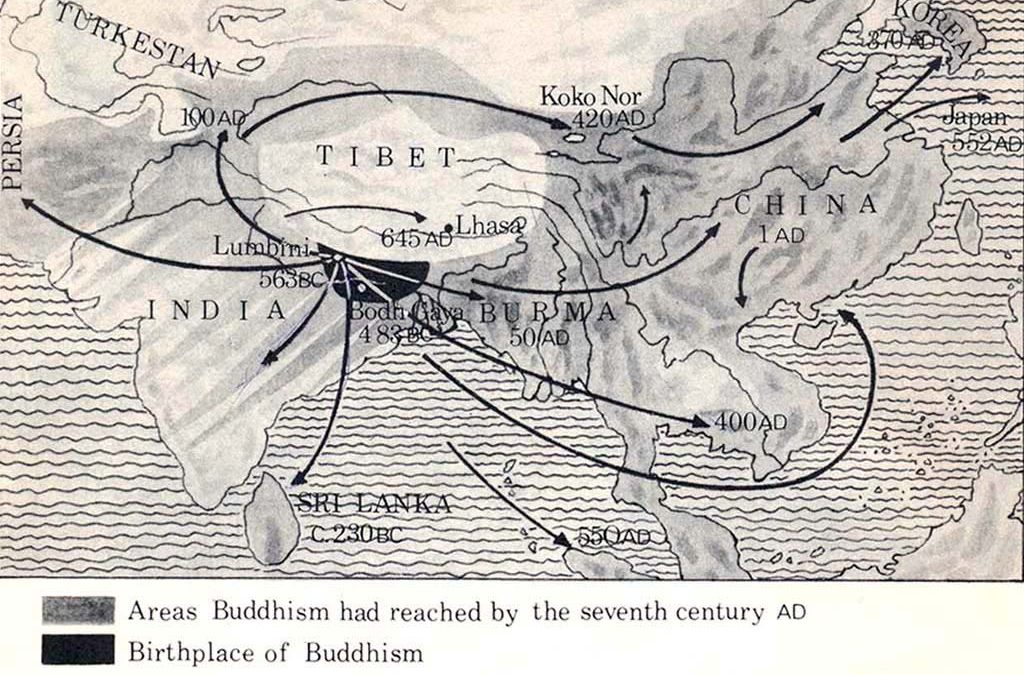One day, so legend tells us, the twenty-eighth king of Tibet, Thori Nyantsen, was standing on the roof of his palace. Suddenly, from out of the sky came a casket, which landed at the astonished king’s feet. In the casket was a book of Buddhist scriptures. The stories say that Thori Nyantsen was unable to read at this time. But he realized this must be a holy book, so he kept it very carefully, though he had no idea what was in it. He called the book ‘Nyenpo Sangwa,’ which means ‘The Secret Scripture.’ Another traditional version of this story describes a Nepalese teacher arriving in Tibet and presenting Thori Nyantsen with the scriptures. The king is also said to have had a dream. In it, the Buddha appeared to him, and told him that after five generations, a king would come who would be able to read and understand this book. Songtsen Gampo was this king.
During the time of the Yarlung kings, many Tibetan merchants and traders journeyed to India and China with their goods. Such men were often the first to learn about new ideas, and to spread these ideas when they returned home. So it seems probable that some Buddhist doctrines reached Tibet before the seventh century. The importance of Songtsen Gampo’s reign is that the Buddhist religion now received official backing for the first time. As we have read, he sent Thonmi Sambhota and sixteen students to India to study. On his return, Thonmi Sambhota gathered a group of dedicated scholars around him and began translating various Buddhist texts, using the new alphabet he had devised. The achievements of these remarkable translators survive to this day – they are the real ‘cultural heroes’ of Tibet.
Songtsen Gampo himself took a great interest in the new scriptures. He became a competent scholar and was soon convinced of the truth of Buddhism. In an attempt to persuade his subjects to follow the new religion, Buddhist rules were included in the laws of the land. Songtsen Gampo also encouraged Buddhist teachers to visit Tibet from both India and China. So the slow process of education began. The Tibetan people did not become converted to Buddhism overnight. There were no monasteries as yet, and it was only within the royal family that Buddhism took a strong hold. The Bon religion still remained a very powerful force for most Tibetans. However, the foundations of the new teachings had been laid.
Songtsen Gampo’s successors also encouraged Buddhism. But, during the reign of Mes Agtshom (704-755), the new religion suffered a setback. A terrible outbreak of smallpox appeared in Lhasa. Mes Agtshom’s Chinese queen caught the disease and died of it. The Bon priests declared that the smallpox had been sent by the ancient gods of Tibet to punish the Tibetans for following the new teachings. People became excited and angry, and the king was forced to expel the Indian teachers and many of their Tibetan followers as well.
Mes Agtshom’s son was the great warrior king, Trisong Detsen. He became a devout Buddhist and was determined to reintroduce the religion in Tibet. According to tradition, the king had two ministers – one called Gos Trisang, who was pro-Buddhist, and the other, called Mashang, who was bitterly opposed to it. Gos Trisang is said to have eliminated his rival by a trick. He bribed an astrologer to prophesize that the king would die young and that a great famine would come to Tibet. The only way these disasters could be averted, declared Gos Trisang, was if the king’s two chief ministers were prepared to sacrifice themselves for their country. Gos Trisang announced that he was willing to make such a sacrifice, and Mashing, who was the king’s uncle, could not very well refuse to join him. The two men were walled up in a burial chamber, but Gos Trisang knew a secret way out. He escaped, but Mashang was left to die…
Trisong Detsen could now encourage the return of Buddhism to Tibet.

